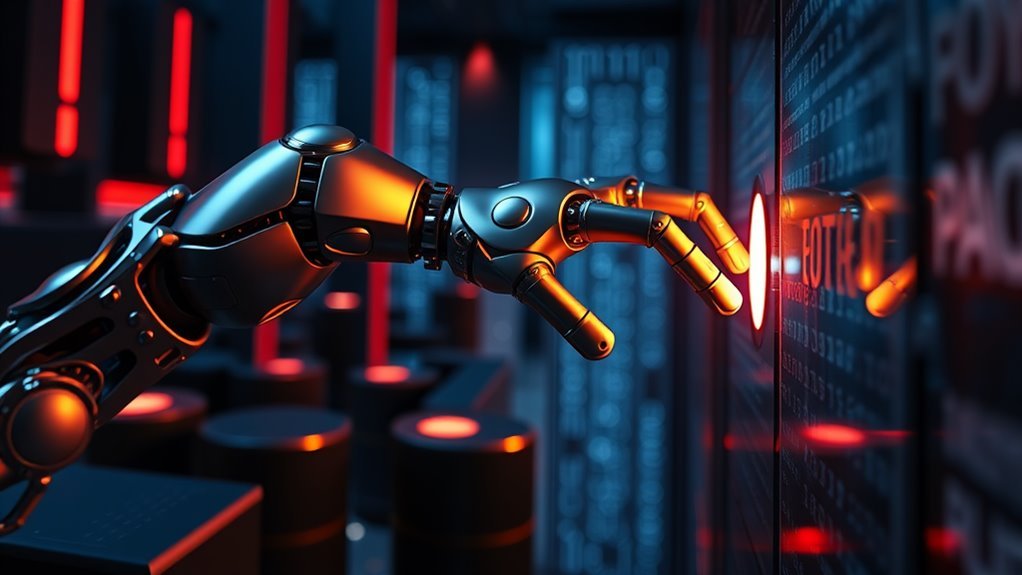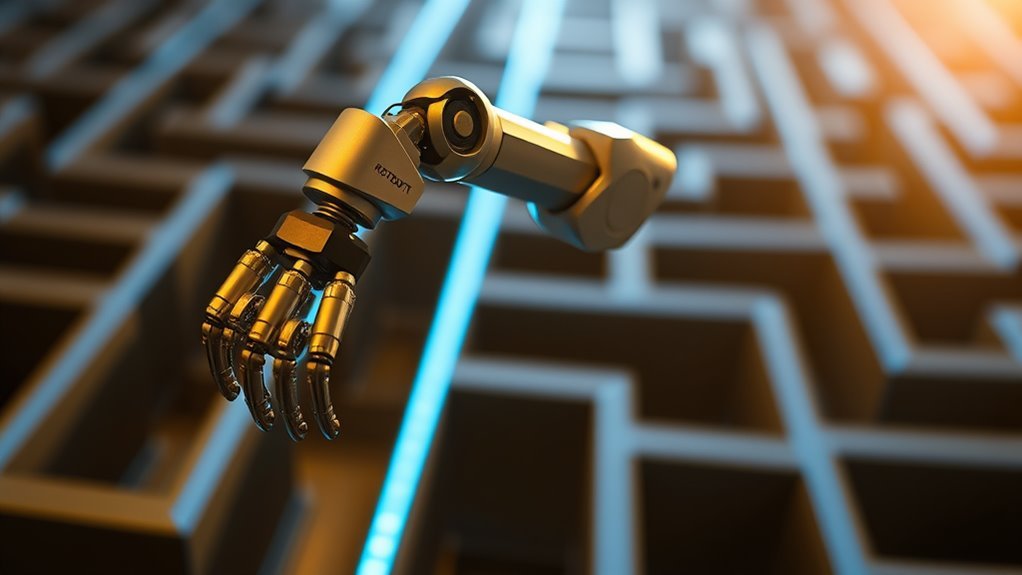You're developing autonomous intelligence with reinforcement learning, which lets agents learn from their environment and make decisions to maximize rewards. You'll investigate value-based methods like Q-Learning and policy-based approaches like REINFORCE. Actor-critic models and deep reinforcement learning will likewise be key. You'll find advanced algorithms and techniques, such as TD3 and SAC, that can help you achieve state-of-the-art results. As you move forward, you'll reveal the best reinforcement learning algorithms to drive your autonomous intelligence projects to the next level.
Need-to-Knows
- Q-Learning is a foundational algorithm.
- DQN handles complex action spaces.
- PPO improves policy learning stability.
- TD3 enhances robustness in actions.
- SAC maximizes rewards with exploration.
Reinforcement Learning Basics
When you immerse yourself in the realm of machine learning, you'll find that Reinforcement Learning (RL) is a paradigm where an agent learns to make decisions by interacting with an environment and receiving feedback in the form of rewards or penalties.
This process involves an agent taking actions in the environment, which then provides rewards or penalties as feedback. You'll see that the agent's goal is to maximize the cumulative rewards over time through a balance of investigation and exploitation.
As you probe deeper into RL, you'll understand that the agent learns from the environment through trial and error, using the rewards to guide its decision-making.
The reinforcement learning process relies on the agent's ability to investigate new actions and exploit known actions that yield high rewards. Through this learning process, the agent refines its strategy to achieve ideal outcomes.
Autonomous Agent Environments
You've seen how reinforcement learning involves an agent learning from its environment through trial and error. In autonomous agent environments, you'll find various states that represent different configurations, greatly influencing the decision-making process of the agent.
These environments are characterized by a shift function that defines the probability of moving from one state to another after an action is taken, and a reward function that provides feedback, guiding the agent towards beneficial actions.
The environment's observability – whether it's fully observable or partially observable – affects the agent's learning efficiency.
You'll as well design the action space, determining the range of choices available to the agent, which influences its learning and adaptation strategies.
The shift function, reward function, and action space all play vital roles in shaping the agent's behavior. By understanding these components, you can develop effective adaptation strategies, enhancing the agent's performance in autonomous agent environments.
Value Based Methods

Value-based methods in reinforcement learning focus on estimating the value of states or actions to inform decision-making, with Q-Learning being one of the most foundational algorithms in this category.
You'll find that Q-Learning is a model-free algorithm, meaning it doesn't require a model of the environment to update its action values based on the rewards received and the expected future rewards.
As you investigate value-based methods, you'll notice that they rely on a Q-table to track the expected utility of taking specific actions in various states.
Here are key aspects of value-based methods:
- Q-Learning: a foundational algorithm in value-based methods
- Q-values: updated using the Bellman equation
- Rewards: immediate and expected future rewards are considered
- Ideal policy: the agent examines to learn the ideal action policy
You'll see that the agent analyzes the environment, updating Q-values iteratively, leading to convergence towards the ideal action-value function as it gains more experience.
The Bellman equation incorporates the immediate reward and the discounted maximum future reward, allowing the agent to learn from its interactions.
Policy Based Approaches
Several key differences set policy-based approaches apart from their value-based counterparts. You'll find that policy-based methods directly optimize the agent's policy, allowing for more flexible and continuous action spaces.
The REINFORCE algorithm is a classic policy gradient method that updates policies based on the received rewards. You'll utilize the concept of discounted future rewards to improve learning, and the log probability of actions taken is essential for updating the policy. This helps reinforce actions that yield higher rewards while mitigating the lower reward actions.
You can handle high-dimensional action spaces more effectively with policy-based methods, making them suitable for complex tasks.
Nevertheless, these approaches can converge to local optima faster, but may likewise face challenges with high variance in their updates. To stabilize learning, you'll need to implement techniques like variance reduction. By doing so, you'll improve the policy gradient and boost the overall learning process. This allows you to optimize the policy and actions taken to maximize rewards.
Actor Critic Models

Policy-based approaches have their strengths, but they can be limited by high variance in updates.
You'll find that actor-critic models can help mitigate this issue by combining the benefits of both policy-based and value-based methods. The actor-critic algorithm uses two neural networks: the actor, which suggests actions based on the current policy, and the critic, which evaluates those actions by estimating value functions, providing feedback to improve the policy.
You can utilize the following key aspects of actor-critic models:
- Handling high-dimensional action spaces: making them suitable for complex tasks
- Temporal difference learning: for updating both actor and critic networks
- Advantage Actor-Critic (A2C) algorithm: enhancing learning efficiency
- Function approximation: using deep learning for improved performance
Deep Reinforcement Learning
Most notably, you'll find that Deep Reinforcement Learning (DRL) integrates deep learning with reinforcement learning, allowing you to train agents that learn complex policies directly from high-dimensional sensory inputs like images or video. This permits agents to learn from raw data, making DRL a key component of reinforcement learning algorithms.
The Deep Q-Network (DQN) is a notable algorithm in DRL, which uses experience replay and target networks to stabilize learning. You can use DRL to train agents that learn actions based on feedback in the form of rewards or penalties.
Asynchronous Actor-Critic Agents (A3C) is another algorithm that allows multiple agents to investigate different parts of the environment simultaneously, improving learning efficiency. Agents learn to make decisions by trial and error, and DRL allows them to adapt to real-world scenarios.
Algorithmic Applications

You've seen how Deep Reinforcement Learning integrates deep learning with reinforcement learning, allowing agents to learn from high-dimensional sensory inputs. This integration has led to the development of powerful RL algorithms, including the Q-learning algorithm and Deep Q-Networks.
When it comes to practical implementation, you'll find that these algorithms have numerous applications of Reinforcement Learning.
Some of the best Reinforcement Learning algorithms for various tasks are:
- Q-learning algorithm for game playing
- Deep Q-Networks for complex tasks
- Proximal Policy Optimization for simulated robotic tasks
- Soft Actor-Critic for robotics and autonomous systems
As you investigate these algorithms, you'll see how they allow an agent to interact with its environment to learn ideal policies.
The key to successful implementation is understanding how these algorithms work and choosing the right one for your specific task. By mastering the best Reinforcement Learning algorithms, you'll be able to tackle complex problems in various fields, from robotics to game playing.
Advanced RL Techniques
Within the domain of Reinforcement Learning, advanced techniques are being developed to tackle complex problems. You'll find that algorithms like A3C, PPO, DQN, TD3, and SAC are leading the way.
A3C, for instance, boosts exploration and speeds up training by leveraging multiple parallel agents, which improves policy learning stability. PPO balances exploration and exploitation using a clipped objective function, ensuring stable updates.
You can use DQN to approximate Q-values for actions in complex environments, enabling learning from high-dimensional state spaces. TD3 introduces techniques like target policy smoothing and delayed updates, strengthening learning robustness.
SAC combines off-policy learning and entropy maximization, allowing you to learn policies that maximize rewards and maintain exploration. By utilizing these advanced techniques, you can advance policy learning, exploration, and rewards in complex environments with neural networks.
These methods will help you tackle challenging problems and achieve better results in Reinforcement Learning.
Most-Asked Questions FAQ
What Is the Best Algorithm for Reinforcement Learning?
You'll choose the best algorithm based on value-based methods, policy gradient, or actor-critic, considering off-policy algorithms, exploration strategies, and hyperparameter tuning for ideal performance in various environments.
Is PPO the Best RL Algorithm?
You'll find PPO has advantages, but it's not perfect, considering PPO disadvantages and comparing PPO vs A3C, to determine its performance and stability in your specific use cases and training needs.
What Three Types of Learning Algorithms Are Used to Train an AI Model?
You're using Supervised, Unsupervised, and Semi-Supervised Learning algorithms, which aren't limited to Reinforcement Learning, and can be combined with Deep Learning, Transfer Learning, and Online Learning for effective AI model training.
Is Chatgpt Reinforcement Learning?
You're wondering if ChatGPT uses reinforcement learning, it doesn't, but its capabilities include human-like responses through neural network integration and feedback mechanisms.
Conclusion
You're now equipped to tackle complex problems with the best reinforcement learning algorithms. You'll master autonomous intelligence by applying value-based, policy-based, and actor-critic models. Deep reinforcement learning and advanced techniques will help you optimize performance. You'll develop innovative solutions, pushing the boundaries of autonomous agent capabilities. You'll drive progress in this field.
